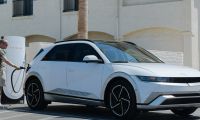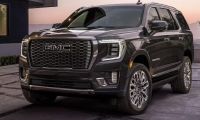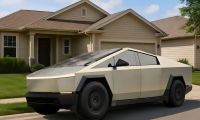If you're into automotive, then you think of a car as being a frame onto which an engine (or motor) is mounted along with a transmission, some body work, four tires, and a windshield to make a complete vehicle. The driver climbs in, starts up the engine or gives power to the motor and drives off. Now take all of that, except the four wheels, body work, and windshield and throw it out. A car, says Ingo Valentin, inventor of the INGOCAR, is just a vehicle we get around in. It's how the car gets around that we need to rethink. Totally.
And he's done so. For years, Valentin has been working on a design in his own field of expertise: hydraulics. His idea? Toss the frame, the engine, the transmission, the brakes, and all that goes with them and replace them with hydraulic cylinders and motors.
What Valentin has done is strip modern vehicles of all of their complex systems and replaced them with pure simplicity. Electric cars are simple, but still complicated thanks to the electronics required to control them and the heavy batteries needed to store their energy. A hydraulic car is even simpler, with few (if any) control electronics required and with the hydraulic storage system itself doubling as the framework for the car. Saving space, complexity, energy, and weight.
The frame for the INGOCAR is simply an I-shaped tubular form onto which front and rear chassis components are bolted (see photo). The frame and chassis are not only modular, but scalable, so they can be up- or down-sized to create any type of vehicle preferred, from a compact car to a heavy big rig. Inside each wheel is a hydro-propelled motor with reversing valves. These motors propel the car forward or are reversed to act as brakes. When braking, they return hydraulic pressure to the tanks (frame tubes) for future use.
That's right, the Valentin design relies on compressed hydraulic fluids to store power and provide propulsion. No batteries, no oversized engines, and this braking system is capable of restoring 70-85% of the forward motion back into the car's energy storage. Compare that to electric regeneration, which is usually capable of about half that (or less).
To keep the fluids compressed and the power flowing, Valentin has two ideas: a small electric compressor or a larger, but in the end more efficient opposed piston motor. The electric would require batteries, which add to the weight of the vehicle as well as reduce its potential range. The opposed piston engine would actually have a higher MPG potential and could run on any number of fuels, depending on options preferred - so the OP engine could run on diesel, biodiesel, greasel, etc. or could be one running on gasoline, natural gas, ethyl, etc. Using a simple 2-stroke diesel opposed free piston engine on a small car with good aerodynamics, Valentin says the INGOCAR would be capable of 170mpg.
Now here's another kicker: think you'll be giving up performance? Imagine the power and performance (and instant torque) of a Tesla Roadster, but without the batteries or the noise of a traditional muscle car. The INGOCAR in a small car frame would have 670hp in potential and a 0-60mph speed of under 5 seconds. In all wheel drive, to boot.
In a crash, the I-shaped tubes are very unlikely to break, being made of the same carbon fiber layers used to make today's most advanced compressed gas cylinders for on-vehicle storage. The liquids and gases inside are not flammable nor explosive and can be made environmentally neutral as well.
Skeptical? Hydraulic assist is currently being marketed by several companies to heavy truck fleets. Refuse (garbage) trucks in Florida, New York, and other places are using the technology to save fuel and boost productivity at significant cost savings. So why isn't Valentin's car on the market? I asked him.
"I have seen far more red tape than expected. It seems it is really not red tape, more like DNA. However, if the concept and its benefits are realized, the majority of people would like it (little money for gas and zero to 60 in four seconds) and it would be difficult to directly oppose it. I assume some might try it anyway, but the possible benefits - no dependency on foreign sources of oil and clean air - are not easily overcome. In Germany, industrial vehicles (forklifts) are allowed to be built and operated with a hydrostatic power train as the main braking system. This means there is a has already been a thought process in this direction."
Which just goes to show: innovate and there will be bureaucrats to stop you.
You can find out more about the INGOCAR at Valentin Technologies.












Comments
Great tech article! Please
Permalink
Great tech article! Please confirm the noise level for this particular company's technology arrangement . Reason is, I did an article on a hydraulic hybrid bus last summer, and the experience was quite loud. Hydraulic pumps and fluid l flowing are not known for their low decibels, even as they recharge the accumulator and release pressure; grat for trucks and busses, but I'm not sure for cars; although the potential is there.
Good point and one I hadn't
Permalink
In reply to Great tech article! Please by Frank Sherosky
Good point and one I hadn't thought of, Frank. The car has not yet been built in prototype form, only proof of concept, so that's likely an issue that will have to be addressed. I have operated a fully hydraulic powered (no engine/motor, just compressed hydraulics) crane lift before, however, and it was only loud when exerting a lot of force (i.e. lifting heavy loads) and was nearly silent when swiveling or raising/lowering empty riggers.
I have also seen hydraulic-assisted (using the Parker system) refuse trucks in action and didn't note any more noise than is normally associated with the diesel engines on board, though I did note that the air brakes were much quieter.
The Ingocar Valentin approach
Permalink
The Ingocar Valentin approach is commendable indeed. He has motor-in-wheel motor/pumps. These act a motor and pump (kinetic energy braking reclaim) and the brakes. All simple, light, small and all in one unit. Brilliant.
My reservation is efficiency of the driving motors. I do not actually know it. On part load many hydraulic motors lose efficiency. A British company has produced the Digital Displacement hydraulic motor pump. This is electronically controlled and loses no efficiency at any speed range or loading. This motor/pump is obviously more complex than simple hydraulic motors. The company, Artemis, in 2008 converted a BMW 530i equipped with a Digital Displacement Hybrid transmission to prove a point. MPG improved by 100% in city driving. This in a far from optimized configuration using a lot of the existing BMW mechanicals. Transmission progression was seamless.
They used the standard 3 litre engine turning a hydraulic pump which charged a small accumulator. Two Digital Displacement hydraulic motor/pumps drove the cars two rear wheels. If the accumulator was bigger the engine need only be around 1000cc. Or sized for average hp down a highway, approx 20-30 hp. The web site has videos and documents of the testing, etc.
artemisip.com/appli_auto_transm.htm
Very cool. Thanks, John.
Permalink
In reply to The Ingocar Valentin approach by John (not verified)
Very cool. Thanks, John.
Aron, In 1978, a bunch of
Permalink
In reply to Very cool. Thanks, John. by Aaron Turpen
Aron,
In 1978, a bunch of student crudely adapted a VW Beetle to a petro-hydraulic hybrid using off-the-shelf components and replacing the 60hp engine with a 16hp engine. It did 70mph and 70mpg. Proof it can work in small vehicles has been around for a while, like approaching 40 years. The large manufacturers also stayed they could improve mpg but the cost of the equipment was far too expensive for the mass market. Yet, nearly 20 years ago the EPA estimated that produced in high volumes the hydraulic components would add only $700 to the base cost of a vehicle in a project they did.
Proof of concept, R&D and proof of economic manufacturing costs has been around for decades. No big auto maker took it up.
The blank paper up design by Ingocar Valentin must be the way forward for this design. A car designed to accommodate the mechanicals of a petro-hydraulic hybrid. He does "claim" that his hydraulic wheel hub motors have vastly improved efficiency over some current offerings. One thing is clear is that the Digital Displacement motor/pump by Artemis, is highly efficient at all speed and loads and is for sale now. The motor/pump I would assume is not exactly cheap being electronically controlled and complex to other pumps. So how it melts into manufacturing costs I am not sure. Also, these more efficient motor/pumps needs mass producing for mass made autos, which should drop costs.
The Citroen DS19 had hydraulic suspension (which incorporated the damping), and braking all in one system. In 1955!!!! Even then it was recognised that the suspension movement could charge an accumulator.
An engine turning a hydraulic pressure pump needs optimizing. Lotus have a 1,000cc 3 cylinder, light, small design designed specifically for hybrid applications, hydraulic and electric. Jaguar are considering using the engine in a petro-electric hybrid. This engine is being tooled for manufacturing in Spain. I do not have much faith in the Chrysler/EPA test minivan project as they are still using the oversized standard 2.4 liter engine. This will be far too large and will return poorer mpg than a smaller matched engine. The minivan body is also not designed for petro-hydraulic applications. This project can only be a compromise, as the Artemis BMW was.
I have a feeling the general public will not accept a car with very pressure fluid running around. In a crash they will fear the worst. Failure effects of high pressure fluid can be minimized, but still a major point to sell.
The 1978 link:
motherearthnews.com/Green-Transportation/1978-03-01/This-Car-Travels-75-Miles-on-a-Single-Gallon-of-Gasoline.aspx
John
It's possible that Valentin
Permalink
In reply to Aron, In 1978, a bunch of by John (not verified)
It's possible that Valentin was involved in many of those early hydraulic designs. He's been working on this particular concept for over 20 years and has been an engineer working in the hydraulic field for his entire career. I don't recall his exact age, but in talking with him, I do know that he would likely have been in university in the late1970s.
An external combustion
Permalink
In reply to It's possible that Valentin by Aaron Turpen
An external combustion Stirling engine is ideal for this charging only application where instant HP and torgue is not essential form the charging engine. Stirlings are more efficient than IC engines but physically larger for the same HP, and slow to start up (a plus is that no starter motor is needed) but this is not a drawback in this application. Stirlings are silent, much cleaner being just an efficient burner and much simpler. As only a small HP engine is needed only to charge the accumulator, the Stirling is the unit to use. The Segwy (sp?) man has spent millions on Stirling development and isusing one in small petro-electric hybrid under test. He proposes a small scooter using a petro-electric hybrid setup.
Stirlings are used in Swedish and Japanese submarines. One small Stirling Swedish sub "sunk" the USS Ronald Reagan in war games. The USN could not detect the quiet sub. The crew love the silence of the Stirling operation reducing stress on-board. It can stay submerged for weeks using deisel and liquid oxygen. Stirlings are not things of yesterday, despite predating the IC enhine by 100 years. They are used in Compined Heat & Power applications in domestic homes.
The one drawback with petro-hydraulic setups is public acceptance of all that fluid under high pressure. They will think of what happens when there is an impact. Another is when a flexible hose pipe bursts, and fluid is lost and over the road or driveway. The cost of the replacement fluid is not exactly cheap. Which make me think the petro-electric hybrid will win as battery and supercapacitor technology is improving at a decent rate. But right now the simple, efficient, petro-hydraulic setup using a Stirling engine is by far the best.
Aron, In 1978, a bunch of
Permalink
In reply to Very cool. Thanks, John. by Aaron Turpen
Aron,
In 1978, a bunch of student crudely adapted a VW Beetle to a petro-hydraulic hybrid using off-the-shelf components and replacing the 60hp engine with a 16hp engine. It did 70mph and 70mpg. Proof it can work in small vehicles has been around for a while, like approaching 40 years. The large manufacturers also stayed they could improve mpg but the cost of the equipment was far too expensive for the mass market. Yet, nearly 20 years ago the EPA estimated that produced in high volumes the hydraulic components would add only $700 to the base cost of a vehicle in a project they did.
Proof of concept, R&D and proof of economic manufacturing costs has been around for decades. No big auto maker took it up.
The blank paper up design by Ingocar Valentin must be the way forward for this design. A car designed to accommodate the mechanicals of a petro-hydraulic hybrid. He does "claim" that his hydraulic wheel hub motors have vastly improved efficiency over some current offerings. One thing is clear is that the Digital Displacement motor/pump by Artemis, is highly efficient at all speed and loads and is for sale now. The motor/pump I would assume is not exactly cheap being electronically controlled and complex to other pumps. So how it melts into manufacturing costs I am not sure. Also, these more efficient motor/pumps needs mass producing for mass made autos, which should drop costs.
The Citroen DS19 had hydraulic suspension (which incorporated the damping), and braking all in one system. In 1955!!!! Even then it was recognised that the suspension movement could charge an accumulator.
An engine turning a hydraulic pressure pump needs optimizing. Lotus have a 1,000cc 3 cylinder, light, small design designed specifically for hybrid applications, hydraulic and electric. Jaguar are considering using the engine in a petro-electric hybrid. This engine is being tooled for manufacturing in Spain. I do not have much faith in the Chrysler/EPA test minivan project as they are still using the oversized standard 2.4 liter engine. This will be far too large and will return poorer mpg than a smaller matched engine. The minivan body is also not designed for petro-hydraulic applications. This project can only be a compromise, as the Artemis BMW was.
I have a feeling the general public will not accept a car with very pressure fluid running around. In a crash they will fear the worst. Failure effects of high pressure fluid can be minimized, but still a major point to sell.
The 1978 link:
motherearthnews.com/Green-Transportation/1978-03-01/This-Car-Travels-75-Miles-on-a-Single-Gallon-of-Gasoline.aspx
John